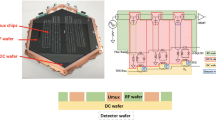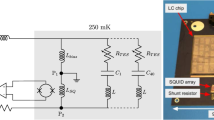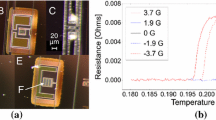Abstract
The Simons Observatory (SO) is an upcoming polarization-sensitive cosmic microwave background experiment on the Cerro Toco Plateau (Chile) with large overlap with other optical and infrared surveys (e.g., DESI, LSST, HSC). To enable the readout of \({\mathcal {O}}\)(10,000) detectors in each of the four telescopes of SO, we will employ the microwave SQUID multiplexing technology. With a targeted multiplexing factor of \({\mathcal {O}}\)(1000), microwave SQUID multiplexing has never been deployed on the scale needed for SO. Here we present the design of the cryogenic coaxial cable and RF component chain that connects room temperature readout electronics to superconducting resonators that are coupled to transition edge sensor bolometers operating at sub-Kelvin temperatures. We describe design considerations including cryogenic RF component selection, system linearity, noise, and thermal power dissipation.


Similar content being viewed by others
Notes
From COAX CO., LTD. http://www.coax.co.jp/en/.
References
P. Ade et al., The Simons Observatory: science goals and forecasts. J. Cosmol. Astropart. Phys. 2019(2), 056 (2019). https://doi.org/10.1088/1475-7516/2019/02/056
A. Ali, et al., Small aperture telescopes for the Simons Observatory. This special issue (2019)
A.N. Bender et al., On-sky performance of the SPT-3G frequency-domain multiplexed readout. J. Low Temp. Phys. (2019). https://doi.org/10.1007/s10909-019-02280-w
T. Dahm, D.J. Scalapino, Theory of intermodulation in a superconducting microstrip resonator. J. Appl. Phys. 81(4), 2002–2009 (1997). https://doi.org/10.1063/1.364056
P.J. de Visser et al., Readout-power heating and hysteretic switching between thermal quasiparticle states in kinetic inductance detectors. J. Appl. Phys. 108(11), 114504 (2010). https://doi.org/10.1063/1.3517152
B. Dober et al., Microwave SQUID multiplexer demonstration for cosmic microwave background imagers. Appl. Phys. Lett. 111(24), 243510 (2017). https://doi.org/10.1063/1.5008527
N. Galitzki, et al., The Simons Observatory: instrument overview, in, Society of Photo-Optical Instrumentation Engineers (SPIE) Conference Series, vol. 10708, p. 1070804 (2018). https://doi.org/10.1117/12.2312985
J. Gao, The physics of superconducting microwave resonators. Ph.D. thesis, Caltech (2008)
J. Gao et al., A semiempirical model for two-level system noise in superconducting microresonators. Appl. Phys. Lett. 92(21), 212504 (2008). https://doi.org/10.1063/1.2937855
S.W. Henderson et al., Advanced ACTPol cryogenic detector arrays and readout. J. Low Temp. Phys. 184(3–4), 772–779 (2016). https://doi.org/10.1007/s10909-016-1575-z
S.W. Henderson, et al., Highly-multiplexed microwave SQUID readout using the SLAC microresonator radio frequency (SMuRF) electronics for future CMB and sub-millimeter surveys, in Society of Photo-Optical Instrumentation Engineers (SPIE) Conference Series, vol. 10708, p. 1070819 (2018). https://doi.org/10.1117/12.2314435
Y. Li, et al., Assembly and integration process of the high-density detector array readout system for the Simons Observatory. This special issue (2019)
J.A.B. Mates, The microwave squid multiplexer. Ph.D. thesis, University of Colorado (2011)
S. McHugh et al., A readout for large arrays of microwave kinetic inductance detectors. Rev. Sci. Instrum. 83(4), 044702–044702 (2012). https://doi.org/10.1063/1.3700812
D.M. Pozar, Microwave Engineering, 3rd edn. (Wiley, Hoboken, 2005)
I. Siddiqi et al., Direct observation of dynamical bifurcation between two driven oscillation states of a Josephson junction. Phys. Rev. Lett. 94, 027005 (2005). https://doi.org/10.1103/PhysRevLett.94.027005
Acknowledgements
This work was supported in part by a Grant from the Simons Foundation (Award # 457687).
Author information
Authors and Affiliations
Corresponding author
Additional information
Publisher's Note
Springer Nature remains neutral with regard to jurisdictional claims in published maps and institutional affiliations.
Maximiliano Silva-Feaver have provided significant contribution to this work.
Rights and permissions
About this article
Cite this article
Sathyanarayana Rao, M., Silva-Feaver, M., Ali, A. et al. Simons Observatory Microwave SQUID Multiplexing Readout: Cryogenic RF Amplifier and Coaxial Chain Design. J Low Temp Phys 199, 807–816 (2020). https://doi.org/10.1007/s10909-020-02429-y
Received:
Accepted:
Published:
Issue Date:
DOI: https://doi.org/10.1007/s10909-020-02429-y




